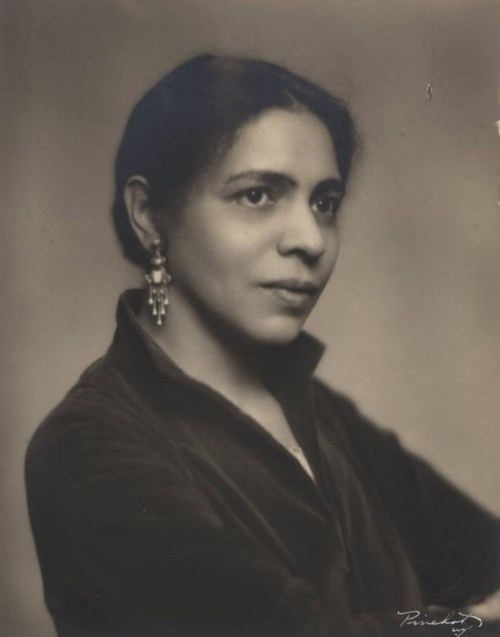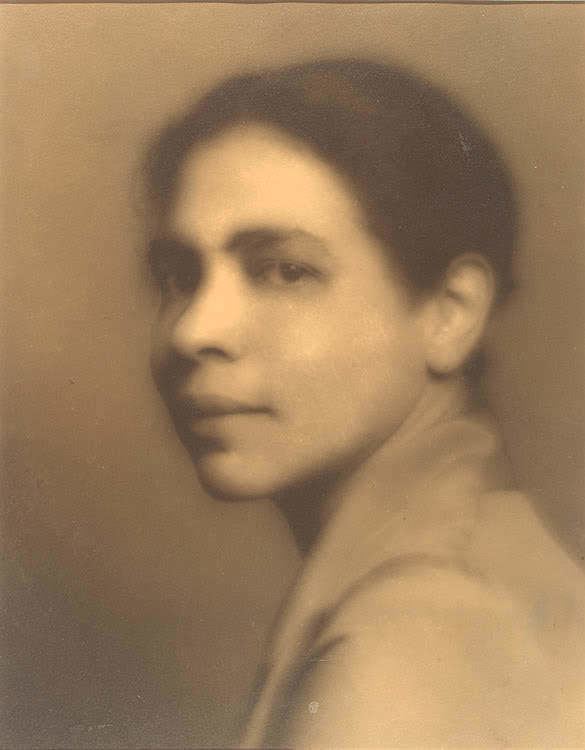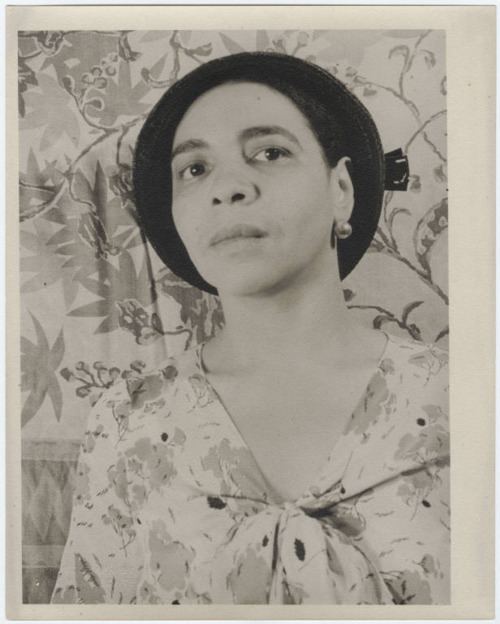Full Name Nellie Walker Name Nella Larsen | Role Novelist | |
 | ||
Other names Nellallitea Larsen, Nellye Larson, Nellie Larsen, Nella Larsen Imes Ethnicity Afro Caribbean, Danish American Alma mater Occupation Novelist, librarian, nurse Education University of Copenhagen (1910–1912), Fisk University (1907–1908), Lincoln Hospital, Columbia University Books Passing, Quicksand, Quicksand & Passing, The complete fiction of, An intimation of things | ||
Mixed minute nella larsen
Nellallitea "Nella" Larsen, born Nellie Walker (April 13, 1891 – March 30, 1964), was an American novelist of the Harlem Renaissance. Working as a nurse and a librarian, she published two novels, Quicksand (1928) and Passing (1929), and a few short stories. Though her literary output was scant, she earned recognition by her contemporaries. A revival of interest in her writing has occurred since the late 20th century, when issues of racial and sexual identity have been studied. Her works have been the subjects of numerous academic studies and she is now widely lauded "not only the premier novelist of the Harlem Renaissance, but also an important figure in American modernism."
Contents
- Mixed minute nella larsen
- The mixed experience minute nella larsen harlem renaissance author afro viking
- Early life
- Nursing career
- Marriage and family
- Librarian and literary career
- Later life
- 1928 Quicksand
- 1929 Passing
- References

The mixed experience minute nella larsen harlem renaissance author afro viking
Early life

Nella Larsen was born Nellie Walker in a poor district of Chicago known as the Levee, on April 13, 1891, the daughter of Peter Walker, likely a mulatto Afro-Caribbean immigrant from the Danish West Indies and Marie Walker, née Hansen, a Danish immigrant. Her mother was a seamstress and domestic worker. Her father was likely a mixed-race descendant of Henry or George Walker, white men from Albany, New York, who settled in the Danish West Indies about 1840. In that Danish society, racial lines were more fluid and Walker may never have identified as "Negro." He soon disappeared from the lives of Nella and her mother; she said he had died when she was very young. At this time, Chicago was filled with immigrants but the Great Migration had not begun from the South, and the black population was 1.3% in 1890 and still only 2% in 1910, near the end of her childhood on the South Side.

Her mother, Marie, married Peter Larsen, a fellow Danish immigrant, by whom she had another daughter, Anna. Nellie took her stepfather's surname, sometimes using versions spelled as Nellye Larson, Nellie Larsen, and finally on Nella Larsen. The mixed family moved west to a mostly white neighborhood of German and Scandinavian immigrants, but encountered discrimination. When Nella was eight, they moved a few blocks back east. The author and critic Darryl Pinckney wrote of her anomalous situation:
"as a member of a white immigrant family, she [Larsen] had no entrée into the world of the blues or of the black church. If she could never be white like her mother and sister, neither could she ever be black in quite the same way that Langston Hughes and his characters were black. Hers was a netherworld, unrecognizable historically and too painful to dredge up."
Most American blacks were from the South, and Larsen had no connection with them.
As a child, Larsen lived for a few years with relatives in Denmark, possibly in Jutland. While she was unusual in being of mixed race, she had some good memories of that time. Back in Chicago, she attended a large public school. As migration of blacks increased to the city, so did racial segregation and tensions in the immigrant neighborhoods. Her mother believed in education for girls and supported Larsen in attending Fisk University, a historically black university in Nashville, Tennessee. In 1907-08, for the first time Larsen was living within a black community; although she was still separated from most of the students, who were from the South. Biographer George B. Hutchinson found that she had been expelled for some violation of Fisk's strict dress or conduct codes. Larsen went to Denmark for four years and then returned to the US but struggled to find a place where she could belong.
Nursing career
In 1914, Larsen enrolled in the nursing school at New York City's Lincoln Hospital and Nursing Home. Founded in the 19th century in Manhattan as a nursing home to serve blacks, the hospital elements had grown in importance. The total operation had been relocated to a newly constructed campus in the South Bronx. At the time, the hospital patients were primarily white; the nursing home patients were primarily black; the doctors were male and white; and the nurses and nursing students were female and black. As Pinckney writes: "No matter what situation Larsen found herself in, racial irony of one kind or another invariably wrapped itself around her."
Upon graduating in 1915, Larsen went South to work at the Tuskegee Institute in Tuskegee, Alabama, where she became head nurse at its hospital and training school. While at Tuskegee, she was introduced to Booker T. Washington's model of education and became disillusioned with it. As it was combined with poor working conditions for nurses at Tuskegee, Larsen decided to leave after a year or so.
She returned to New York in 1916, where she worked for two years as a nurse at Lincoln Hospital. After earning the second-highest score on a civil service exam, Larsen was hired by the city Bureau of Public Health as a nurse. She worked for them in the Bronx through the 1918 flu pandemic, in "mostly white neighborhoods" and with white colleagues, and afterward.
Marriage and family
In 1919, Larsen married Elmer Imes, a prominent physicist; he was the second African American to receive a PhD in physics. After her marriage, she sometimes used the name Nella Larsen Imes in her writing. A year after her marriage, she published her first short stories.
The couple moved to Harlem in the 1920s, where their marriage and life together had contradictions of class. As Pinckney writes:
"By virtue of her marriage, she was a member of Harlem's black professional class. She and her husband knew the NAACP leadership: W.E.B. Du Bois, Walter White, James Weldon Johnson. However, because of her low birth and mixed parentage, and because she didn't have a college degree, Larsen was alienated from the life of the black middle class, with its emphasis on school and family ties, its fraternities and sororities."
Her mixed parentage was not itself unusual in the black middle class, but many, such as Hughes, had more distant European ancestors and belonged to a mixed-race elite, some of whom had ancestors who were free people of color well before the American Civil War. In the 1920s, people in Harlem were emphasizing their black heritage.
The Imes couple had difficulties by the late 1920s and divorced in 1933.
Librarian and literary career
In 1921 Larsen worked nights and weekends as a volunteer with librarian Ernestine Rose, to help prepare for the first exhibit of "Negro art" at the New York Public Library (NYPL). Encouraged by Rose, she became the first black woman to graduate from the NYPL Library School, which was run by Columbia University and opened the way for integration.
Larsen passed her certification exam in 1923 and spent her first year working at the Seward Park Branch on the Lower East Side, which was predominantly Jewish, where she had strong support from her white supervisor Alice Keats O'Connor, as she had from Rose. They, and another branch supervisor where she worked, supported Larsen and helped integrate the staff of the branches. Larsen transferred to the Harlem branch, as she was interested in the cultural excitement in the neighborhood.
In October 1925, Larsen took a sabbatical from her job for health reasons and began to write her first novel. In 1926, having made friends with important figures in the Negro Awakening (which became known as the Harlem Renaissance), Larsen gave up her work as a librarian.
She became a writer active in Harlem's interracial literary and arts community, where she became friends with Carl Van Vechten, a white photographer and writer. In 1928, Larsen published Quicksand, a largely autobiographical novel. It received significant critical acclaim, if not great financial success.
In 1929, she published Passing her second novel, which was also critically successful. It dealt with issues related to two mixed-race African-American women who were childhood companions and had taken different paths of racial identification and marriage. One married a black doctor and the other married a white man, without revealing her African ancestry. The book explored their experiences of coming together again as adults.
In 1930, Larsen published "Sanctuary", a short story for which she was accused of plagiarism. "Sanctuary" was said to resemble the British writer Sheila Kaye-Smith’s short story, "Mrs. Adis", first published in the United Kingdom in 1919. Kaye-Smith wrote on rural themes, and was very popular in the US. Some critics thought the basic plot of "Sanctuary," and some of the descriptions and dialogue, were virtually identical to Kaye-Smith's work.
The scholar H. Pearce has taken issue with this assessment, writing that, compared to Kaye-Smith’s tale, "Sanctuary" is '... longer, better written and more explicitly political, specifically around issues of race - rather than class as in "Mrs Adis" ." Pearce thinks that Larsen reworked and updated the tale into a modern American black context. Pearce also notes that in her 1956 book, All the Books of My Life, Kaye-Smith said she had based "Mrs Adis" on a 17th-century story by St Francis de Sales, Catholic bishop of Geneva. It is unknown whether she knew of the Larsen controversy.
No plagiarism charges were proved. Larsen received a Guggenheim Fellowship in the aftermath of the controversy. She used it to travel to Europe for several years, spending time in Mallorca and Paris, where she worked on a novel about a love triangle in which all the protagonists were white. She never published the book or any other works.
Later life
Larsen returned to New York in 1933, when her divorce had been completed. She lived on alimony until her ex-husband's death in 1942. Struggling with depression, Larsen stopped writing. After her ex-husband's death, Larsen returned to nursing and became an administrator. She disappeared from literary circles. She lived on the Lower East Side and did not venture to Harlem.
Many of her old acquaintances speculated that she, like some of the characters in her fiction, had crossed the color line to "pass" into the white community. Biographer George Hutchinson has demonstrated in his 2006 work that she remained in New York, working as a nurse. She avoided contact with her earlier friends and world.
Larsen died in her Brooklyn apartment in 1964, at the age of 72.
1928: Quicksand
Helga Crane is a fictional character loosely based on Larsen's experiences in her early life. Crane is the lovely and refined mixed-race daughter of a Danish white mother and a West Indian black father. Her father died soon after she was born. Unable to feel comfortable with her European-American relatives, Crane lives in various places in the United States and visits Denmark, searching for people among whom she feels at home.
In her travels she encounters many of the communities which Larsen knew. For example, Crane teaches at Naxos, a Southern Negro boarding school (based on Tuskegee University), where she becomes dissatisfied with its philosophy. She criticizes a sermon by a white preacher, who advocates the segregation of blacks into separate schools and says their striving for social equality would lead blacks to become avaricious. Crane quits teaching and moves to Chicago. Her white maternal uncle, now married to a bigoted woman, shuns her. Crane moves to Harlem, New York, where she finds a refined but often hypocritical black middle class obsessed with the "race problem."
Taking her uncle's legacy, Crane visits her maternal aunt in Copenhagen, where she is treated as a highly desirable racial exotic. Missing black people, she returns to New York City. Close to a mental breakdown, Crane happens onto a store-front revival and has a charismatic religious experience. After marrying the preacher who converted her, she moves with him to the rural Deep South. There she is disillusioned by the people's adherence to religion. In each of her moves, Crane fails to find fulfillment. She is looking for more than how to integrate her mixed ancestry. She expresses complex feelings about what she and her friends consider genetic differences between races.
The novel develops Crane's search for a marriage partner. As it opens, she has become engaged to marry a prominent Southern Negro man, whom she does not really love, but with whom she can gain social benefits. In Denmark she turns down the proposal of a famous white Danish artist for similar reasons, for lack of feeling. By the final chapters, Crane has married a black Southern preacher. The novel's close is deeply pessimistic. Crane had hoped to find sexual fulfilment in marriage and some success in helping the poor southern blacks she lives among, but instead she has frequent pregnancies and suffering. Disillusioned with religion, her husband, and her life, Crane fantasizes about leaving her husband, but never does.
1929: Passing
In Larsen's Novel Passing it begins with Irene receiving this mysterious letter from her childhood friend Clare after they reconnected at the Drayton after twelve years with no communication. Irene and Clare lost contact with each other after the death of Clare's father Bob Kendry, where Clare was sent to live with her white aunts. Both Irene and Clare come from African and European ancestry, which allows them to pass over. Clare chose to fully pass as a white woman by marrying a white racist named John Bellew, but unlike Clare, Irene passes as a white woman on occasion. Irene identifies herself as a black woman, she is married to an African American doctor named Brian and together they have two sons. After Irene and Clare reconnect they both have a fascination with each other's lifestyles. Irene meets with Clare and another one of their childhood friend Gertrude, during that meeting Mr. Bellew meets Irene and Gertrude. Mr. Bellew greets his wife with a racial comment as if he did not know his wife was half black. Irene becomes furious with the fact that Clare did not tell her husband she is half black. Irene believes Clare has put herself in a dangerous situation by lying to a person who hates blacks. After meeting Clare's husband Irene does not want anything to do with Clare but still keeps in contact with her. Clare begins to join Irene and Brian to all of their events in Harlem, New York while her husband goes out of town. Because Irene has jealous feelings towards Clare she begins to believe her husband and Clare are having and affair together. The Novel ends with John Bellew finding out Clare's mixed race and Clare ends up "falling" out of a multi-story building window. Larsen ends the novel without telling us if Clare committed suicide, if Irene pushed her, or if it was an accident.
Many see this novel as an example of the plot of the tragic mulatto, a common figure in early African-American literature after the American Civil War. It is usually a woman of mixed race who is portrayed as tragic, with difficulty marrying and finding a place to fit into society. Others suggest that the novel complicates that plot by introducing the dual figures of Irene and Clare, who in many ways mirror each other but also introduce differences. The novel also suggests erotic undertones in the two women's relationship, and a potential bisexuality in Irene's husband, as if the characters are passing in their sexual identities. Some read the novel as one of repression. Others argue that through its attention to the way "passing" unhinges ideas of race, class, and gender, the novel opens spaces for the creation of new, self-generated identities.
Since the late 20th century, Passing has received renewed attention from scholars because of its close examination of racial and sexual ambiguities and liminal spaces. It has achieved canonical status in many American universities.
